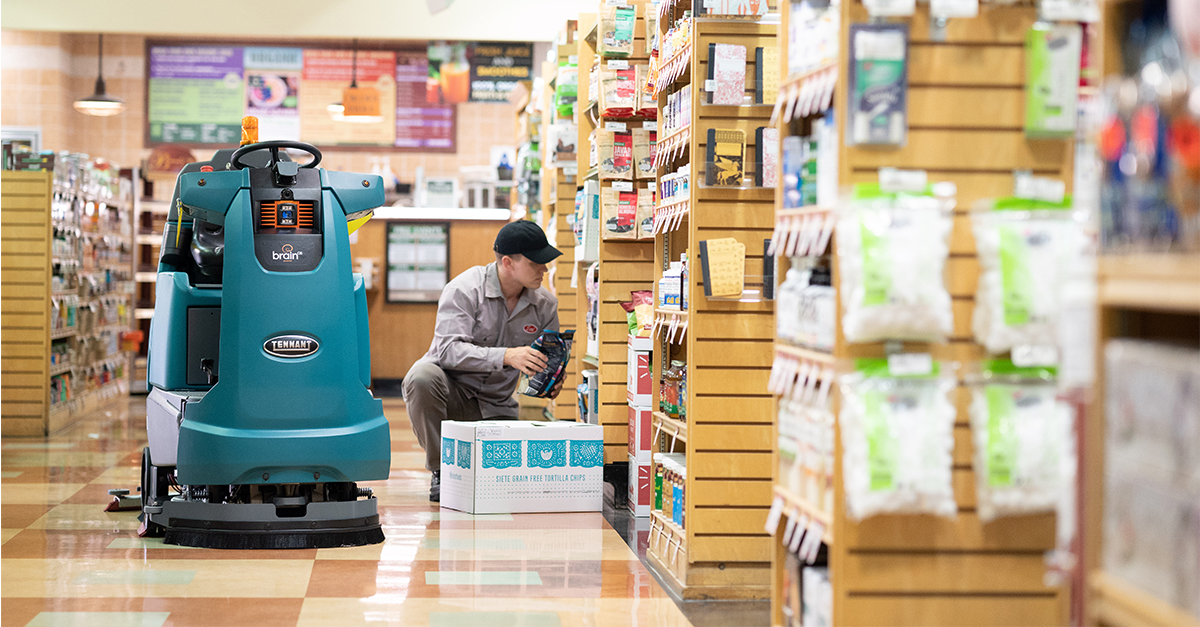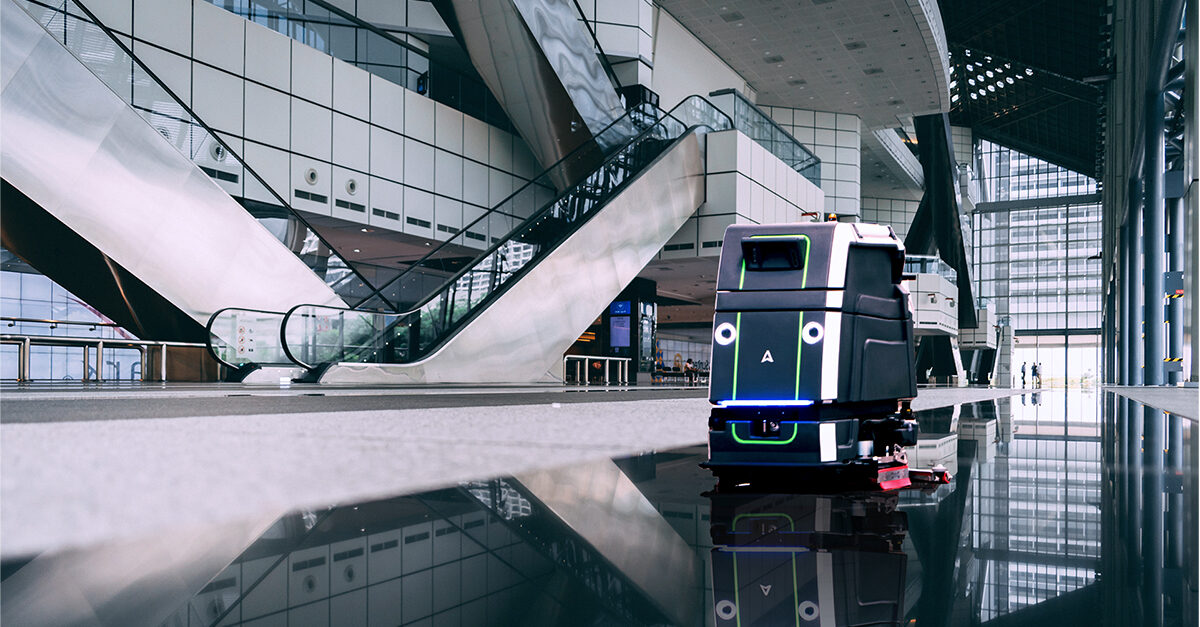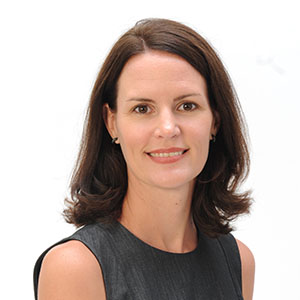Robotic floor scrubbers have come a long way since the first models hit the cleaning scene in the early 2000s. But it took nearly two decades for them to find commercial success. That breakthrough came in October 2018 when Walmart announced it would deploy autonomous floor scrubbing machines in 360 stores.
Following a cleaning routine in play at many retail stores, a Walmart associate at every location spent two hours a day riding or walking behind the scrub machine to keep floors sparkling clean. The introduction of self-driving scrubbers, powered by Brain Corp.’s assisted autonomous technology, freed these associates to take care of other tasks like tidying restrooms, dust-mopping the checkout aisles, or engaging with customers. The workers simply prepped the floor area and mapped the machine’s route, then pressed a button to start the floor cleaning process.
Today there are thousands of “intelligent cleaners” deployed globally in retail and grocery stores, malls, airports, schools, hospitals, and other public locations. This growth is due to advances in technology that have made robotic solutions more efficient and easier to operate and afford.
“The main difference between those very early versions and the machines of today have to do with the quality of sensors and cameras for autonomous navigation, the sophistication of the artificial intelligence (AI), safety, ease of use, cleaning efficiency, and much more,” said Alan Butcher, Vice President of Global Client Services at Brain Corp., a provider of AI and robotics technology used in autonomous scrubbers, vacuums and other applications. “It’s literally night and day—probably what you would expect from two decades of innovation.”
As navigation systems have improved, more original equipment manufacturers (OEMs) are jumping on board, said Dennis Collins, senior product manager at Tennant Company, which introduced its first autonomous floor scrubber, T7AMR, in 2018 and has since launched two more models, one for small spaces and one for larger industrial customers. These models run on Brain Corp.’s robotic AI software platform, BrainOS®, which also powers floor care machines made by ICE Robotics, Minuteman, Kärcher, and Nilfisk.

Image courtesy of Brain Corp.
The path to proliferation
Based on a 2019 study by ABI Research, autonomous mobile robots are projected to be the fastest-growing category in the mobile robot market between 2020 and 2030. ABI predicted a significant sector for mobile automation would be maintenance and cleaning, noting 5,000 autonomous floor scrubbers were already in U.S. retail stores and commercial buildings at the end of 2019.
The reason that robotic scrubbers are proliferating, and even becoming the new commercial cleaning standard, according to Butcher, is because they serve a straightforward purpose. “Robots are good at tackling dull, repetitive, labor-intensive tasks, and floor care is one of them,” he said.
Rising labor costs, increasing health and safety concerns, and limited resources are other factors contributing to the rapid implementation of robot cleaners, including autonomous floor scrubbers, said Faizan Sheikh, CEO and cofounder of Canadian-based Avidbots, which debuted its fully autonomous floor scrubbing robot Neo in 2017.
“The cost of cleaning labor continues to rise across North America. By implementing a robotic solution like Neo, organizations are able to reallocate 93% of that labor to other business-critical or value-added tasks,” Sheikh said. “This allows organizations using autonomous floor scrubbers to focus on revenue-generating activities.”
The pandemic effect
Freeing up staff to do other high-value tasks has been a major selling point of robotics during the recent health crisis. The pandemic helped bring the value of robotic automation to the forefront, especially in retail and other essential businesses, Butcher said. “We saw a big spike in autonomous activity at U.S. retailers last year, especially in the second quarter when robotic usage rose 24% compared to the previous year. For Brain Corp, this has translated into strong growth. We saw more than a 300% increase in deployments of BrainOS-powered scrubbers in 2020, and we have seen strong demand continue into this year.”
Avidbots has seen a 100% demand increase for its robot since March 2020, particularly from airports, warehousing and logistics centers, manufacturing facilities, schools, and retailers. “We anticipate demand will continue to remain high once the crisis has passed, as society will continue to demand a much higher level and frequency of cleaning and disinfection than before and businesses will be required to retain higher and more frequent cleaning protocols,” Sheikh said.
Collins said Tennant Company has found that “customers are embracing robotics more than ever before” during the pandemic. “The pandemic has put a focus on cleanliness and cleanliness is now part of a company’s brand,” he said. “Automation can help our customers improve the cleanliness of their facilities, creating healthier and safer spaces for their employees and customers.”

Image courtesy of ICE Robotics
The numerous benefits
In addition to labor reallocation and the increased productivity that comes with it, Collins notes robotic floor scrubbers can address many key end user needs, including increased measurability of their cleaning efforts, reduced costs, enhanced customer/employee experience, and proof they are keeping pace with innovation.
Consistency of performance is a major benefit, too, according to Kris Dihrkop, director of strategic accounts, and Chris Wetmore, vice president of sales, at ICE Robotics. A robot can be counted on for consistency and completing a task in exactly the same way, “so you know what to expect every single time you deploy a machine,” Dihrkop said.
Using autonomous machines can also lower insurance costs, stemming from reduced worker injuries and reduced damaged to merchandise caused by human errors, Butcher notes.
Perhaps the most exciting development in recent years is how robotic floor scrubbers can now provide a “confirmed” or “measurable” clean.
“With a manual solution the floor cleaning cannot be quantified or qualified,” Sheikh said. “There is no way to track what was cleaned and with what efficacy. Autonomous solutions on the other hand provide metrics and data on every single cleaning operation…Cleaning operations can use these metrics to optimize floor care over a period of time.”
A return on investment
Return on investment (ROI) for robotic automation varies by customer, but end users can maximize their ROI by looking at their operations holistically, Collins said. When calculating ROI consider including everything from reduced costs to enhanced worker productivity and improved customer experiences.
While there is no “magic number,” the payback period for a large-scale investment in robotic floor scrubbers can be as little as 12-18 months depending on usage patterns and customer goals, Butcher said. “For certain industries, such as retail, this ROI can be greatly accelerated with the addition of other add-on applications to the robotic scrubber, such as a shelf-scanning accessory that collects valuable inventory insights to reduce out-of-stocks, verify pricing and planogram compliance, and improve customer experiences,” Butcher said.
Sheik also believes a 12- to 18-month payback is achievable depending on labor rate, facility size, and robot deployment frequency.
Customers with a higher volume and frequency of cleaning needs typically achieve ROI quicker, said Dihrkop at ICE Robotics. “How you procure and maintain the product is part of the equation: all-inclusive subscriptions provide lower total cost of ownership and help clients more quickly realize ROI.”



